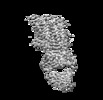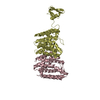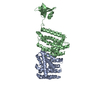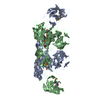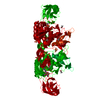+ Open data
Open data
- Basic information
Basic information
| Entry | Database: EMDB / ID: EMD-21460 | ||||||||||||
|---|---|---|---|---|---|---|---|---|---|---|---|---|---|
| Title | Cryo-EM structure of SLC40/ferroportin in complex with Fab | ||||||||||||
 Map data Map data | structure of SLC40/ferroportin in complex with Fab | ||||||||||||
 Sample Sample |
| ||||||||||||
| Function / homology |  Function and homology information Function and homology informationiron ion transmembrane transporter activity /  peptide hormone binding / basolateral plasma membrane / intracellular iron ion homeostasis / peptide hormone binding / basolateral plasma membrane / intracellular iron ion homeostasis /  nucleoplasm / nucleoplasm /  cytosol cytosolSimilarity search - Function | ||||||||||||
| Biological species |   Carlito syrichta (Philippine tarsier) / Carlito syrichta (Philippine tarsier) /   Mus musculus (house mouse) Mus musculus (house mouse) | ||||||||||||
| Method |  single particle reconstruction / single particle reconstruction /  cryo EM / Resolution: 3.0 Å cryo EM / Resolution: 3.0 Å | ||||||||||||
 Authors Authors | Shen J / Ren Z / Pan Y / Gao S / Yan N / Zhou M | ||||||||||||
| Funding support |  United States, 3 items United States, 3 items
| ||||||||||||
 Citation Citation |  Journal: Nat Commun / Year: 2020 Journal: Nat Commun / Year: 2020Title: Structural basis of ion transport and inhibition in ferroportin. Authors: Yaping Pan / Zhenning Ren / Shuai Gao / Jiemin Shen / Lie Wang / Zhichun Xu / Ye Yu / Preetham Bachina / Hanzhi Zhang / Xiao Fan / Arthur Laganowsky / Nieng Yan / Ming Zhou /  Abstract: Ferroportin is an iron exporter essential for releasing cellular iron into circulation. Ferroportin is inhibited by a peptide hormone, hepcidin. In humans, mutations in ferroportin lead to ...Ferroportin is an iron exporter essential for releasing cellular iron into circulation. Ferroportin is inhibited by a peptide hormone, hepcidin. In humans, mutations in ferroportin lead to ferroportin diseases that are often associated with accumulation of iron in macrophages and symptoms of iron deficiency anemia. Here we present the structures of the ferroportin from the primate Philippine tarsier (TsFpn) in the presence and absence of hepcidin solved by cryo-electron microscopy. TsFpn is composed of two domains resembling a clamshell and the structure defines two metal ion binding sites, one in each domain. Both structures are in an outward-facing conformation, and hepcidin binds between the two domains and reaches one of the ion binding sites. Functional studies show that TsFpn is an electroneutral H/Fe antiporter so that transport of each Fe is coupled to transport of two H in the opposite direction. Perturbing either of the ion binding sites compromises the coupled transport of H and Fe. These results establish the structural basis of metal ion binding, transport and inhibition in ferroportin and provide a blueprint for targeting ferroportin in pharmacological intervention of ferroportin diseases. | ||||||||||||
| History |
|
- Structure visualization
Structure visualization
| Movie |
 Movie viewer Movie viewer |
|---|---|
| Structure viewer | EM map:  SurfView SurfView Molmil Molmil Jmol/JSmol Jmol/JSmol |
| Supplemental images |
- Downloads & links
Downloads & links
-EMDB archive
| Map data |  emd_21460.map.gz emd_21460.map.gz | 28.6 MB |  EMDB map data format EMDB map data format | |
|---|---|---|---|---|
| Header (meta data) |  emd-21460-v30.xml emd-21460-v30.xml emd-21460.xml emd-21460.xml | 14.1 KB 14.1 KB | Display Display |  EMDB header EMDB header |
| Images |  emd_21460.png emd_21460.png | 102.3 KB | ||
| Archive directory |  http://ftp.pdbj.org/pub/emdb/structures/EMD-21460 http://ftp.pdbj.org/pub/emdb/structures/EMD-21460 ftp://ftp.pdbj.org/pub/emdb/structures/EMD-21460 ftp://ftp.pdbj.org/pub/emdb/structures/EMD-21460 | HTTPS FTP |
-Related structure data
| Related structure data |  6vyhMC  6wikC M: atomic model generated by this map C: citing same article ( |
|---|---|
| Similar structure data |
- Links
Links
| EMDB pages |  EMDB (EBI/PDBe) / EMDB (EBI/PDBe) /  EMDataResource EMDataResource |
|---|---|
| Related items in Molecule of the Month |
- Map
Map
| File |  Download / File: emd_21460.map.gz / Format: CCP4 / Size: 30.5 MB / Type: IMAGE STORED AS FLOATING POINT NUMBER (4 BYTES) Download / File: emd_21460.map.gz / Format: CCP4 / Size: 30.5 MB / Type: IMAGE STORED AS FLOATING POINT NUMBER (4 BYTES) | ||||||||||||||||||||||||||||||||||||||||||||||||||||||||||||||||||||
|---|---|---|---|---|---|---|---|---|---|---|---|---|---|---|---|---|---|---|---|---|---|---|---|---|---|---|---|---|---|---|---|---|---|---|---|---|---|---|---|---|---|---|---|---|---|---|---|---|---|---|---|---|---|---|---|---|---|---|---|---|---|---|---|---|---|---|---|---|---|
| Annotation | structure of SLC40/ferroportin in complex with Fab | ||||||||||||||||||||||||||||||||||||||||||||||||||||||||||||||||||||
| Voxel size | X=Y=Z: 1.114 Å | ||||||||||||||||||||||||||||||||||||||||||||||||||||||||||||||||||||
| Density |
| ||||||||||||||||||||||||||||||||||||||||||||||||||||||||||||||||||||
| Symmetry | Space group: 1 | ||||||||||||||||||||||||||||||||||||||||||||||||||||||||||||||||||||
| Details | EMDB XML:
CCP4 map header:
| ||||||||||||||||||||||||||||||||||||||||||||||||||||||||||||||||||||
-Supplemental data
- Sample components
Sample components
-Entire : Cryo-EM map of SLC40/ferroportin in complex with Fab
| Entire | Name: Cryo-EM map of SLC40/ferroportin in complex with Fab |
|---|---|
| Components |
|
-Supramolecule #1: Cryo-EM map of SLC40/ferroportin in complex with Fab
| Supramolecule | Name: Cryo-EM map of SLC40/ferroportin in complex with Fab / type: complex / ID: 1 / Parent: 0 / Macromolecule list: #1-#3 |
|---|---|
| Source (natural) | Organism:   Carlito syrichta (Philippine tarsier) Carlito syrichta (Philippine tarsier) |
| Recombinant expression | Organism:   Trichoplusia ni (cabbage looper) Trichoplusia ni (cabbage looper) |
-Macromolecule #1: Solute carrier family 40 protein
| Macromolecule | Name: Solute carrier family 40 protein / type: protein_or_peptide / ID: 1 / Number of copies: 1 / Enantiomer: LEVO |
|---|---|
| Source (natural) | Organism:   Carlito syrichta (Philippine tarsier) Carlito syrichta (Philippine tarsier) |
| Molecular weight | Theoretical: 63.705004 KDa |
| Recombinant expression | Organism:   Trichoplusia ni (cabbage looper) Trichoplusia ni (cabbage looper) |
| Sequence | String: MSRAREQERQ GGCCRSLANY LTSAKFLLYL GHSLSTWGDR MWHFAVSVFL VELYGNSLLL TAVYGLVVAG SVLVLGAIIG DWVDKNARL KVAQTSLVIQ NVSVILCGII LMMVFLHKDE LLTMYHGWVL TSCYILIITI ANIANLASTA TAITIQRDWI V VVAGEDRS ...String: MSRAREQERQ GGCCRSLANY LTSAKFLLYL GHSLSTWGDR MWHFAVSVFL VELYGNSLLL TAVYGLVVAG SVLVLGAIIG DWVDKNARL KVAQTSLVIQ NVSVILCGII LMMVFLHKDE LLTMYHGWVL TSCYILIITI ANIANLASTA TAITIQRDWI V VVAGEDRS KLANMNATVR RIDQLTNILA PMAVGQIMTY GSPVIGCGFI SGWNLVSMCV EYFLLWKVYQ KTPALAVKAA LK VEETELK QLNLHKDTEP KPLEGTHLMG EKDPNIHELE HEQEPTCASQ MAEPFRTFRD GWVSYYNQPI FLAGMGLAFL YMT VLGFDC ITTGYAYTQG LSGSVLSILM GASAITGIMG TVAFTWLRRK CGLVRTGLIS GWAQISCLIL CVISVFMPGS PLDL SVSPF EDIRSRFIQE ELITPTKIPE TIITTEMHIS NGSDLHIAPE ASPQSVPIIS VSLLFAGVIA ARIGLWSFDL TVTQL LQEN VIESERGIIN GVQNSMNYLL DLLHFIMVIL APNPEAFGLL VLISVSFVVM GHIMYFRFAQ KTLGNQLFVC GPDAKE VTN ENQSNTSVVE NLYQ |
-Macromolecule #2: 11F9 light-chain
| Macromolecule | Name: 11F9 light-chain / type: protein_or_peptide / ID: 2 / Number of copies: 1 / Enantiomer: LEVO |
|---|---|
| Source (natural) | Organism:   Mus musculus (house mouse) Mus musculus (house mouse) |
| Molecular weight | Theoretical: 23.493885 KDa |
| Sequence | String: DIVMTQSQKF MSTSVGDRVS ITCKASQNVG TAVAWYQKKP GQSPKLLIYS ASNRYSGVPD RFTGSGSGTD FTLTISNMQS EDLADYFCQ QYGSYPLTFG SGTKLEIKEA EAAPTVSIFP PSSEQLTSGG ASVVCFLNNF YPKDINVKWK IDGSERQNGV L NSWTDQDS ...String: DIVMTQSQKF MSTSVGDRVS ITCKASQNVG TAVAWYQKKP GQSPKLLIYS ASNRYSGVPD RFTGSGSGTD FTLTISNMQS EDLADYFCQ QYGSYPLTFG SGTKLEIKEA EAAPTVSIFP PSSEQLTSGG ASVVCFLNNF YPKDINVKWK IDGSERQNGV L NSWTDQDS KDSTYSMSST LTLTKDEYER HNSYTCEATH KTSTSPIVKS FNRNE |
-Macromolecule #3: 11F9 heavy-chain
| Macromolecule | Name: 11F9 heavy-chain / type: protein_or_peptide / ID: 3 / Number of copies: 1 / Enantiomer: LEVO |
|---|---|
| Source (natural) | Organism:   Mus musculus (house mouse) Mus musculus (house mouse) |
| Molecular weight | Theoretical: 25.815039 KDa |
| Sequence | String: MKCSWVIFFL MAVVTGVNSE VQLQQSGAEL VRPGALVKLS CKASGFNIKD YYMHWVKERP EQGLEWIGWI DPENGNTIYD PKFQGKASI TADTSSNTAY LQLSSLTSED TAVYYCARKR GYYGPYFDYW GQGTTLTVSS KTTAPSVYPL APVCGDTTGS S VTLGCLVK ...String: MKCSWVIFFL MAVVTGVNSE VQLQQSGAEL VRPGALVKLS CKASGFNIKD YYMHWVKERP EQGLEWIGWI DPENGNTIYD PKFQGKASI TADTSSNTAY LQLSSLTSED TAVYYCARKR GYYGPYFDYW GQGTTLTVSS KTTAPSVYPL APVCGDTTGS S VTLGCLVK GYFPEPVTLT WNSGSLSSGV HTFPAVLQSG LYTLSSSVTV TSSTWPSQSI TCNVAHPASS TKVDKKIEPA |
-Macromolecule #4: COBALT (II) ION
| Macromolecule | Name: COBALT (II) ION / type: ligand / ID: 4 / Number of copies: 2 / Formula: CO |
|---|---|
| Molecular weight | Theoretical: 58.933 Da |
-Macromolecule #5: water
| Macromolecule | Name: water / type: ligand / ID: 5 / Number of copies: 1 / Formula: HOH |
|---|---|
| Molecular weight | Theoretical: 18.015 Da |
| Chemical component information |  ChemComp-HOH: |
-Experimental details
-Structure determination
| Method |  cryo EM cryo EM |
|---|---|
 Processing Processing |  single particle reconstruction single particle reconstruction |
| Aggregation state | particle |
- Sample preparation
Sample preparation
| Concentration | 13 mg/mL |
|---|---|
| Buffer | pH: 7.5 |
| Grid | Model: Quantifoil R1.2/1.3 / Material: COPPER / Mesh: 300 / Pretreatment - Type: GLOW DISCHARGE |
| Vitrification | Cryogen name: ETHANE / Chamber humidity: 100 % / Chamber temperature: 305 K / Instrument: FEI VITROBOT MARK IV |
- Electron microscopy
Electron microscopy
| Microscope | FEI TITAN KRIOS |
|---|---|
| Electron beam | Acceleration voltage: 300 kV / Electron source:  FIELD EMISSION GUN FIELD EMISSION GUN |
| Electron optics | Illumination mode: SPOT SCAN / Imaging mode: BRIGHT FIELD Bright-field microscopy / Nominal defocus max: 2.0 µm / Nominal defocus min: 1.2 µm Bright-field microscopy / Nominal defocus max: 2.0 µm / Nominal defocus min: 1.2 µm |
| Image recording | Film or detector model: GATAN K2 SUMMIT (4k x 4k) / Detector mode: SUPER-RESOLUTION / Average electron dose: 50.0 e/Å2 |
| Experimental equipment |  Model: Titan Krios / Image courtesy: FEI Company |
- Image processing
Image processing
| Initial angle assignment | Type: MAXIMUM LIKELIHOOD |
|---|---|
| Final angle assignment | Type: MAXIMUM LIKELIHOOD |
| Final reconstruction | Applied symmetry - Point group: C1 (asymmetric) / Resolution.type: BY AUTHOR / Resolution: 3.0 Å / Resolution method: FSC 0.143 CUT-OFF / Number images used: 215752 |
 Movie
Movie Controller
Controller



